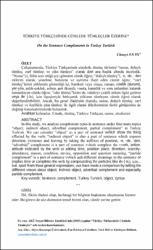| dc.contributor.author | Akın, Cüneyt | |
| dc.date | 2015-04-07 | |
| dc.date.accessioned | 2015-04-07T11:00:16Z | |
| dc.date.available | 2015-04-07T11:00:16Z | |
| dc.date.issued | 2007 | |
| dc.identifier.issn | 1302-1265 | |
| dc.identifier.uri | http://hdl.handle.net/11630/3699 | |
| dc.description.abstract | Çalışmamızda, Türkiye Türkçesinde cümlede tümleç türlerini
“nesne, dolaylı tümleç, zarf tümleci ve edat tümleci” olarak dört ana başlık
altında inceledik. “Nesne”yi, fiilin tesir ettiği şeyi gösteren cümle ögesi;
“dolaylı tümleç”i, -e, -de, -den eklerini alarak, yönelme, bulunma ve ayrılma
ifade eden cümle ögesi; “zarf tümleç”lerini yüklemin gösterdiği işi, hareketi
veya oluşu, zaman, nitelik (durum), yer-yön, azlık-çokluk, sebep, şart
(koşul), vasıta, karşıtlık ve soru anlamları katarak tamamlayan cümle ögesi;
“edat tümleç”lerini de, cümleye çeşitli anlam ilgisi getiren veya ile (-le), için
ilgeçleriyle birleşerek yüklemi tümleyen cümle ögesi olarak
değerlendirebiliriz. Ancak, bu genel ifadelerin dışında, nesne, dolaylı tümleç,
zarf tümleci ve özellikle edat tümleci ile ilgili olarak dilcilerimizin farklı
görüşlerine de değinip karşılaştırmalarda bulunduk. | en_US |
| dc.description.abstract | In this study, we analyze complement types in sentence under four
main topics “object, indirect object, adverbial complement, partial
complement” in Turkey Turkish. We can consider “object” as a part of
sentence which show the thing effected by the verb; “indirect object” is also
a part of sentence which express direction, existence and leaving by taking
the suffixes of position, -e, -de, -den, “adverbial” complement is a part of
sentence which complete the work, action, attitude indicated by the verb as
adding time, position place, direction, scarcity–abundance, reason, condition,
device, opposition and question meaning, “particle complement” is a part of
sentence which add different meanings to the sentence or implies time or
completes the verb by compounding the particles like ile (-le), için… but,
apart from these general expressions, we have made a comparison by telling the different views about object, indirect object, adverbial complement and
especially particle complement. | en_US |
| dc.language.iso | tur | en_US |
| dc.publisher | Afyon Kocatepe Üniversitesi | en_US |
| dc.rights | info:eu-repo/semantics/openAccess | en_US |
| dc.subject | Cümle | en_US |
| dc.subject | Tümleç | en_US |
| dc.subject | Türkiye Türkçesi | en_US |
| dc.subject | Nesne | en_US |
| dc.subject | Sözdizimi | en_US |
| dc.title | Türkiye Türkçesinde Cümlede Tümleçler Üzerine | en_US |
| dc.title.alternative | On Sentence the Complements in Turkey Turkish | en_US |
| dc.type | article | en_US |
| dc.relation.journal | Sosyal Bilimler Dergisi | en_US |
| dc.department | Afyon Kocatepe Üniversitesi, Fen-Edebiyat Fakültesi, Türk Dili ve Edebiyatı Bölümü | en_US |
| dc.identifier.volume | 9 | en_US |
| dc.identifier.startpage | 205 | en_US |
| dc.identifier.endpage | 219 | en_US |
| dc.identifier.issue | 2 | en_US |
| dc.relation.publicationcategory | Makale - Uluslararası Hakemli Dergi - Kurum Yayını | en_US |



















